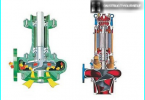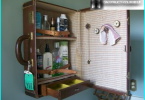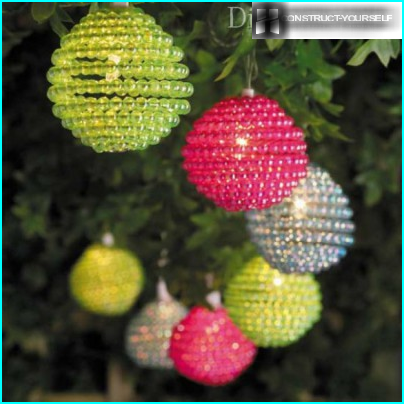
In the view of the inhabitants of the metropolis a country station – a piece of Paradise with a beautiful house, green lawns, fragrant flower beds, a Creek, or a swimming pool, neatly broken beds. But often the reality is the opposite of fabulous ideas, and you get a lot with ravine or at the edge of the hill. Not to worry: the correct slope and landscape decoration will solve all problems.
The contents
If you are the owner of suburban areas with uneven terrain, it surprises to turn in a favorable direction. First you need to think about the unusual advantages of the plot:
- Completely eliminated the stagnation of rain water on any areas having a slope.
- The plane, deployed to the sun, well lit, and therefore on the slope, especially on the South side, will quickly grow ornamental plants and vegetable crops.
- Unusual the area is a unique opportunity the original design of the adjoining territory.
- Taking advantage of topographic features, it is not necessary to erect structures to create a waterfall, cascade or Alpine slide.
Remember about the disadvantages. For planted on a slope plants will need more frequent watering, since water does not linger in the soil. Unlucky lovers of the lawn to achieve a smooth silky carpet on an inclined plane quite difficult. Uneven terrain cannot be used under more practical things, like the Playground or the meadow to relax, and not to install a bench or table. And the main disadvantage – the additional cost of strengthening of slopes and slopes, elevation, the device of beds or flower beds.
So, now we can get down to business. To begin with we suggest you to watch the video, a promotion video clip shows the 5-th best solutions to consolidate slopes. Be sure to review:
Overall, for the correct choice of the method of strengthening it is necessary to consider some factors:
- the structure of the soil;
- the degree of taper;
- the proximity of groundwater;
- the likelihood of natural destruction: landslides, notches, shedding.
Suppose, for a gentle slope enough to the plants that their roots fix the soil and stop the process of destruction. Steep slopes require a more serious approach: shedding can be prevented only by tailor-made design of bimatov, gabions, stones, concrete blocks and geogrids. After selecting the material is necessary to determine the exact work area and produce preparatory work.
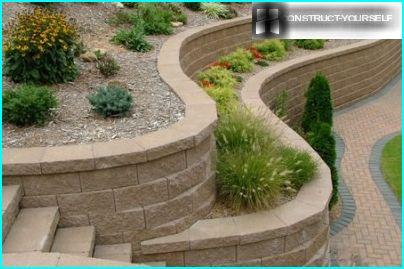
Even the most steep slopes can be turned into a magnificent rock garden, laying out a retaining wall of beautiful decorative tile, and the adjacent walkway — pavers
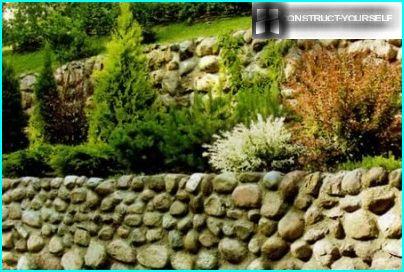
Not necessarily to reinforcing the design of the same type or single layer: construction of stairs and terraces, which expands the area of
Natural method: the use of plants
If the tilt angle does not exceed 8-10 degrees, for the stabilization of the soil cover suitable plants: trees, shrubs, flowers and grass. Their flexible roots deep into the soil, thereby protecting it from landslides and erosions. The most powerful roots of trees, but to plant the whole slope large plants does not make sense. Much more attractive look of the composition of the free-standing small trees and shrubs. For registration or steep edges of the ravine are well-suited broom, elderberry, guelder rose, Japanese quince, sumac, barberry, cotoneaster, wild rose.
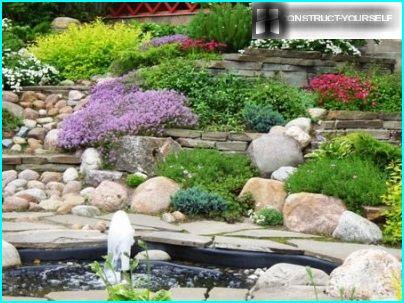
The uneven terrain allows you to create true masterpieces of decorative art: a combination of stones of different shapes, bright colors and flowing water is more than picturesque
Flowering bushes also serve as decorations, like plants with long stems and lush flowers, such as climbing roses. Too bright cocktail of climbing plants be not worth enough for 1-2 densely flowering species. Ground cover plants are perfect for decoration of the inclined surface. Periwinkle, wooly cerastium, ivy, sunflower create a dense carpet that serves as a background for larger types.
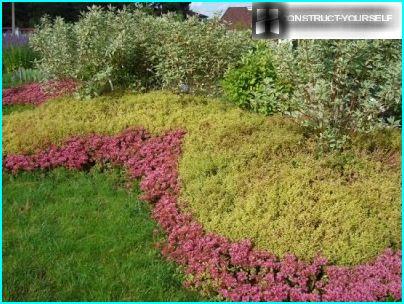
Groundcover is a good way to strengthen the gentle slopes, and with the help of color variation and the difference in height is to hide small defects raised
Uneven terrain with hills, cliffs and valleys – a real find for lovers of Alpine gardens and rockeries. From piles of rocks, pine trees and several kinds of flowers they are able to create a miracle, decoration of any suburban area. The only thing you need to take care before installation of flower garden, to create favorable growing conditions, that is, to ensure regular watering.
Maybe you can something learn from this video story with landscape tricks:
Artificial ways of strengthening
The design of the slope plants are considered natural way to protect from fraying, although the strengthening of the slope at the site may occur and artificial way by using stones, logs and structures from polymeric materials.
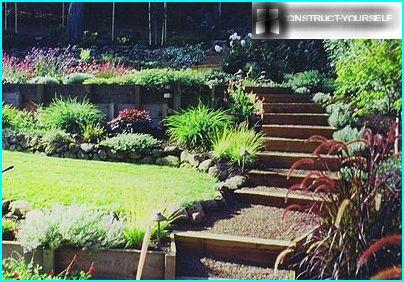
Retaining walls of durable material and ladders — the most common methods of parallel strengthening and decorating the slopes in suburban areas
Option #1 — fences made of stone or logs
Artistically decorated fences of different material well keep the surface of any degree of steepness. Stones or wooden elements placed on the outside of the slope, securing in various ways: by using cement or fixing in the ground (burying in the ground). Limestone slabs, cobbles, rock, chunks of granite stacked in the form of a wall, and the wooden parts are placed ladder or fence.
Article topic: Retaining walls in the landscape: what is and how you can make a good «backup»?
Option #2 — features of laying of geotextile
Steep slopes are difficult to build in a natural way by planting trees or herbs. In this case, makes a geotextile – dense material of polyester or polypropylene fibres which is perfectly waterproof and has high strength. Piece of material stretched on a surface, fixed on all sides by anchors, then decorate. For decorating great natural stone or tile is out of sync with the flowers planted in the fertile soil.
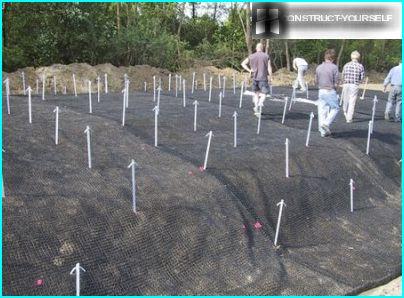
The anchors, which hold the layers of geotextile, after filling with the ground must be removed — not fixed material, if necessary, easily remove
Option #3 — are monofilament and beauty
Both types of soil cover used for a more effective protection of the surfaces with a slope of up to 45% (some types of geomat – up to 70%) when planting. Beauty made from coconut fibers or straw, mounted on a cellulose layer. Are monofilament is a multi – layered grating made of polypropylene. The root system of plants develops immediately, so for instant soil stabilisation at first stack retaining structures, and have them planted plants.
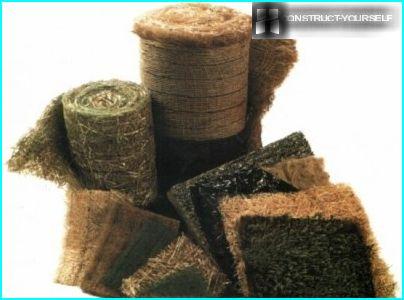
Biomate have two important advantages: the greening of the surface for 2 months and partial fertilizer in the soil due to the decomposition of the material
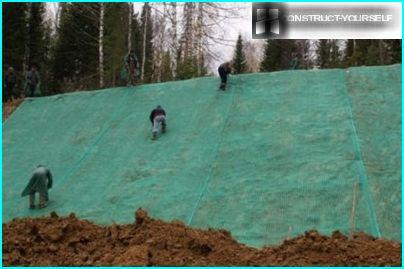
Are monofilament is practical and relatively inexpensive material with many advantages, including easy installation, high efficiency and durability
Rolled material is spread across the surface of the slope, fix the every piece around the perimeter and sown grass or flowers. Loose fibrous structure allows the seed to gain a foothold and to grow, and further to form a thick carpet with an invisible layer of reinforcement.
Option #4 — step-by-step example of installation of the geogrid
Strengthening small area, even a beginning landscape designer, in other words, the owner of the cottage. If there is a small ravine or ditch with crumbling slopes, you can use a volume geogrid is a modern polymer tape design.
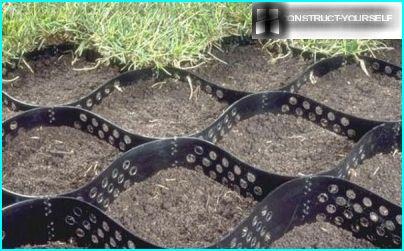
When the cells of the geogrid soil vegetable, you can prepare the best soil for the planting of climbing or erect flowers, lawn grass, small shrub
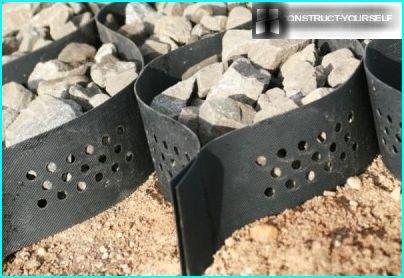
If the country house or bath stands on the edge of the cliff, then Geocell-reinforced gravel is a great way to create an obstacle to the gradual destruction of the slope
Welded together elements reminiscent of the grid with large cells that fill the heavy construction material: rubble, sand, concrete or nutritious soil for planting.
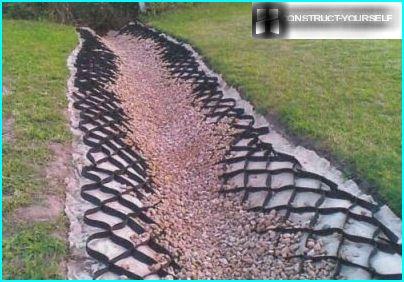
Strengthening both the slope of the ditch that crosses a suburban area, you can create an original stone Creek or unusual rockery with conifers and flower beds
Before starting the reinforcement should prepare the ground: to remove large plants, to align and to compact the soil as possible. There are two options for laying geogrid: geotextiles on or directly on the ground. In the first case, the entire width of the slope, spread a geotextile, which acts as a drainage layer, then put on top of the bars. The second option involves the direct installation of grid – once on the clearing.
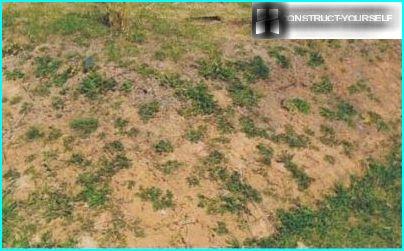
Special fracture-prone slopes, consisting of sand or other sediments are exposed to wind and rain begin to crumble
Cells of the geogrid should be placed along the slope. The basic principle of choosing the material: the steeper the slope, the wider the tape. The segment grid is stretched in different directions and fixed along the perimeter of the anchors or specially planed pegs.
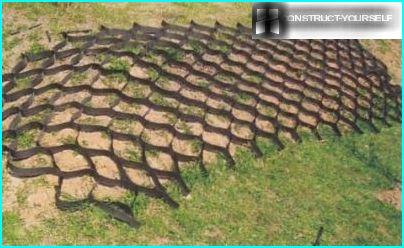
On small slopes, especially in dry areas where it is not needed drainage, geogrid, only one additional insulating material is not necessary
Cells fall asleep or retaining gravel (sand), or soil under the turf. If you are going to flower planting, the soil must be fertile and fertilized.
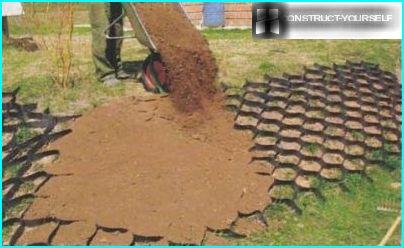
For filling the grid with soil or sand you can use construction transport garden cart or just a bucket with a shovel
This is one of the simplest options for strengthening the slope in the country. By incorporating imagination and using one of the methods of decoration can be an ordinary scree slope turned into a blooming garden is beautiful and original.



